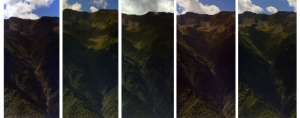’Scape Chasing: Etseri, Svaneti
BLOG
It’s my favorite part of the view southwards from the house, and it can change by the minute, let alone by the hour, day, week or season. So I keep careful watch on it (when I can afford the time).
There are two essential components to good landscape photography. One is simply the location which grabs you. The other is the lighting, which mutates that location’s personality moment by moment. Unless luck is all on your side when you happen across the scene at first, you’ll be coming back to seek the perfect light time and again. Which can be fun too.
There are slow changes: the sun’s track across the sky altering shadows, the color of the light from reddish at dawn and sunset to bluish at midday. The actual change in the sun’s very path from day to day, because in the northern hemisphere, in midsummer it can go directly overhead, whereas in winter it will hardly rise above the mountains, if you have such in your view.
Quicker alterations in the light happen as it passes through clouds. These are the ones to watch second by second, because their interplay with the ground can be most dramatic.
Now, they say that the best times for dramatic landscape lighting in general are when the sun is low in the sky: especially early and late in the day, obviously. But you have more of these low-angle hours to play with in winter, because the sun stays lower anyway, and less in summer for the opposite reason. BUT! If your subject is vertical anyway, or mostly so, it isn’t dependent on the sun to rake across it at low angles to dramatize its form. Such subjects as mountains can benefit from light at any angle, any time of day, simply because they themselves are so far from flat.
Strong sun gives strong shadows, dramatic contrasts, but perhaps obscures colors thus with its extremes. Cloud-filtered light is softer and can reveal form and hues better, though it may not be as powerful. You just have to… re-visit your scene over and over again, or lie in wait to see how the various factors affecting its lighting change over time.
I did this today, over a midday hour, setting up the camera on a tripod and observing from an open upstairs window my favorite scene. There were clouds moving, so the light did change moment to moment. I was shooting in a manual mode: focus, aperture and shutter speed all pre-set so I wouldn’t have to think about them, just shoot.
Each picture would be a vertical panorama made up of essentially the same 6 shots, which a freeware program, Microsoft’s Image Composite Editor (ICE), would stitch together seamlessly into perfect wholes. Usually I take the shots hand-held, lining them up carefully in the viewfinder, but this time I wanted a minimum of wasted space. In the hour, I took 72 frames, which would lead to 12 stitched panoramas of the same scene, each subtly different from the others.
Then I did my usual basic editing in Photoshop to restore colors and contrasts which the great distance of my subject had toned down, and had my 12 images to compare and choose from. One of them I plan to print huge, as I have the mega-pixels to play with, frame, and hang upstairs in a spot over the staircase waiting, begging even, to be filled. Such are the processes of landscape photography, and the privileges of living in such a magnificent living landscape. Not wasted on me, oh no.
By Tony Hanmer
Tony Hanmer has lived in Georgia since 1999, in Svaneti since 2007, and been a weekly writer for GT since early 2011. He runs the “Svaneti Renaissance” Facebook group, now with over 1900 members, at www.facebook.com/groups/SvanetiRenaissance/
He and his wife also run their own guest house in Etseri: w.facebook.com/hanmer.house.svaneti












